
Selling
I don’t like to see collectors overpay, but let’s face it — buyers take care of themselves. Collecting is an addiction, and collectors know the game. They discover where to buy and how to buy. They learn the jargon. If they stick around long enough, they learn the peculiarities of the market and the people within it.
The problem is that collectors are wired for buying. Unless they leave the task to their offspring or beneficiaries, they will, sooner or later, need to sell.
That is when problems start. Giving advice about selling is one of my constant challenges. In my mind, selling has changed dramatically with the advent of eBay. I am not saying eBay is bad. I am saying that eBay has made selling seem overly easy.
My dad was a mechanic. I grew up with grease and metal. While I learned how to grind heads and valves before age 12, I learned something much more valuable. I learned to do what I was good at, and let other people do what they were good at. That is why, today, I work with information and I let other people work with engines.
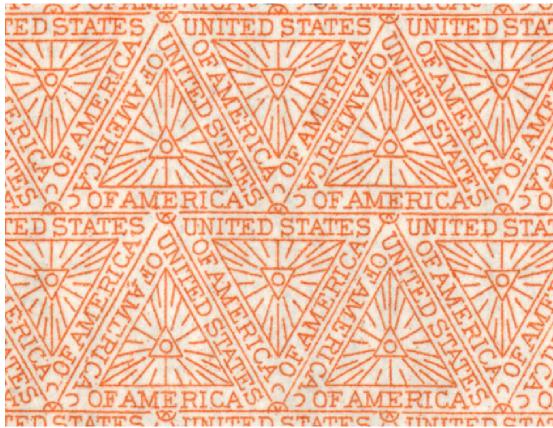 Taken singularly, it would have been trivial to counterfeit one unit of this design. However, by repeating simple designs hundreds of times in underprints, bank note companies made documents terribly hard to reproduce. Repetitive underprints were used frequently on paper money during the 1850s and 60s. Their uses on stocks and bonds, though, was curiously limited, possibly testifying to the difficulty of covering large areas of paper without flaws
Taken singularly, it would have been trivial to counterfeit one unit of this design. However, by repeating simple designs hundreds of times in underprints, bank note companies made documents terribly hard to reproduce. Repetitive underprints were used frequently on paper money during the 1850s and 60s. Their uses on stocks and bonds, though, was curiously limited, possibly testifying to the difficulty of covering large areas of paper without flaws
I say this because I don’t think most collectors make good sellers. I believe most collectors should leave selling to the pros. Some people are good at buying and others are good at selling. Do what you’re good at and let the pros do their thing! I hate to say this so bluntly, but even if you think pros will sell for too little, they will probably still outsell you or me.
Ebay has made selling easy, but easy selling does not mean easy money. And it does not mean fair prices.
In this newsletter, I will present hard facts about selling that collectors should know. I want you to understand some of the realities of liquidating collections.
Selling a personal or parent’s collection is not easy. If the collection is extensive and possibly valuable, then I emphatically recommend contacting dealers and auction houses.
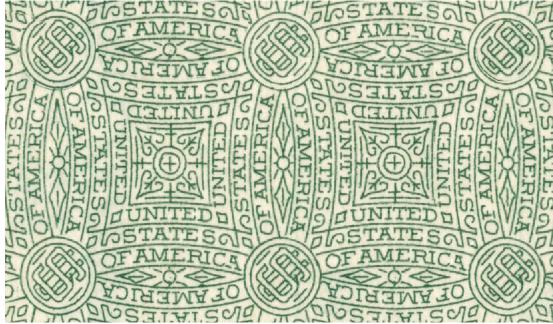
I suspect “United States of America” was the most popular theme for repetitive underprints. “American Bank Note Company” appears often, mainly on temporary certificates. I do not remember seeing any other bank note company names used as underprints.
I will say that again.
Use my book and web site database to get a “feel” for whether your or your parent’s collection is genuinely valuable. If there are many items that catalog for more than a hundred dollars, then PLEASE, PLEASE, PLEASE contact professionals.
If the collection is full of unissued certificates and common material cataloging for less than $20, you will probably do okay selling on your own. You won’t get rich, but your destiny will be yours.
In between are difficult-to-decide situations. If you want to try to sell on your own, give it a try. Sell your least valuable certificates first. Gain experience. Sell your valuable items after you’ve received your education. Another approach is to sell cheap items yourself and let professionals sell the expensive ones.
117 New certificate varieties since August
|
June
letter |
This
letter |
| Number of certificates listed (counting all variants of issued, specimens, etc.) |
21,292 |
21,459 |
| Number of distinct certificates known |
16,148 |
16,265 |
| Number of certificates with celebrity autographs |
1,605 |
1,609 |
| Number of celebrity autographs known |
340 |
341 |
| Number of railroads and railroad-related companies known |
25,274 |
25,301 |
| Number of companies for which at least one certificate is known |
6,820 |
6,851 |
| Serial numbers records |
74,444 |
75,453 |
Let’s really compare sales prices
I adjust prices every day of every week. My goal is simple. I try to show what collectors are generally paying for certificates.
But...like every other price guide in the world...users must adjust my price estimates to their particular markets. They cannot expect my estimates to apply to all situations.
You see, European collectors value certificates differently than American collectors. Prices realized in FHW auctions are different than those in Boone auctions. Smythe’s and Winslow’s auction prices differ from their fixed price offerings. Collectors always pay differently at shows than they do on web sites.
If you see an item listed in my catalog for $50, then I am predicting that collectors will probably pay $40 to $60 in live U.S. auctions. I’d expect collectors to pay $50 to $80 in European auctions. I’d expect buyers on eBay (US) to pay $25 to $30.
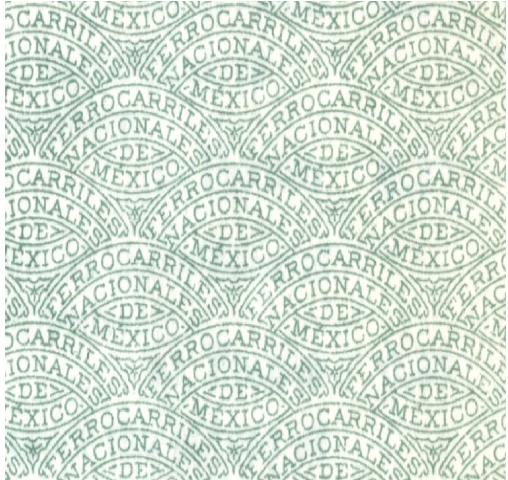
Myopia is a profitable human frailty for eyeglass retailers. Nearsightedness is also rather beneficial for certificate collectors. This design based on a company name is a perfect example of simplicity. It appears as an underprint on a short-term note from the Ferrocarriles Nacional de Mexico in 1914. Its value as a security measure results from the fact that the design covers 56 square inches (!) of paper. Can you imagine a counterfeiter, even a near-sighted one, trying to copy the same design 882 times? (Counterfeiters rarely had access to cylindrical dies which would have made replication easy.)
It is inescapable that eBay has changed the hobby. Huge numbers of people buy and sell on eBay. I have warned time and time again that eBay is a buyers’ market. You will need to adjust my prices substantially to know what to expect in a buyers’ market. In buyers’ markets, buyers RARELY pay top dollar.
Buyers’ markets develop when there are too many willing sellers relative to the number of willing buyers. While eBay gives sellers the potential of reaching hundreds of millions of buyers, there are millions of sellers. Many certificates are perpetually offered for sale, so buying interest is diluted.
Review the numbers of bidders after certificates sell. You will see high-priced certificates generally attract 10 or fewer bidders. Average certificates attract five or fewer bidders. Many bidders are not particular serious; they are “bottom feeding,” trolling for insane bargains.
I have explained this phenomenon many times, but I still hear from sellers who are surprised when their items sell for low amounts on eBay. Or don’t sell at all.
I stress that there is a major difference between selling on eBay and selling with auction house professionals. Professionals are professionals because they specialize in getting more money for their consigned items.
I bet you want hard proof.
Okay. I searched my entire database and located all certificates, as identical as possible, that sold in both live auctions and on eBay within six months of each other. In order to make valid comparisons, I restricted my search to identical varieties with identical characteristics, such as issuance, cancellations, and autographs.
Prices were converted to U.S. dollars at contemporaneous exchange rates. Live auction prices came from Smythe, Winslow, and Jackson (in the U.S.), Boone (in Belgium), FHW, HWPH, and HSK (in Germany.). All prices include commissions, but exclude shipping costs. European sales include value added taxes. I have eBay prices for the last five years, so my comparisons run from November, 2001 to October, 2006.
I compared all sales that took place above $25. Of that number, I found 144 items that sold in live auctions that I could compare very closely with 544 items on eBay.
I found that, overall, buyers on eBay paid about 45% of the amounts they paid in live auctions.
To learn about performances in different price ranges, I divided sales into five categories, based on prices realized in live auctions. Again, I stress that I compared essentially identical items. I did NOT include any certificate unless it was in the same condition and sold in both a live auction and eBay within six months.
The table below clearly shows that certificates priced below $50 sell better on eBay.
Table showing average certificate prices realized (comparing only essentially identical items)
|
Live
auctions |
eBay |
eBay price
as % of live
auction price |
| $500 and up |
$586 |
$137 |
23% |
| $250 to $499 |
$303 |
$118 |
39% |
| $100 to $249 |
$154 |
$65 |
42% |
| $50 to $99 |
$76 |
$53 |
70% |
| $25 to $49 |
$39 |
$51 |
130% |
| all ($25+) |
$148 |
$67 |
45% |
This is perfectly understandable. Auction houses have high overheads and cannot afford to sell many low-value items. Describing certificates and producing catalogs is expensive. They must focus on better material. Often, they must combine low priced certificates into multi-item lots to keep their per-item costs manageable.
The truth is, sub-$50 items can be sold very easily on eBay. They can be described easily and every certificate can be illustrated. The numbers prove that buyers bid aggressively on sub-$50 certificates on eBay.
However, the table shows (quite dramatically!) that collectors freely pay more for rarities in live auctions. Note that price differentials between eBay and auction houses become increasingly pronounced with increasing certificate values.
Regardless of whether you sell your collections on your own, sell to dealers, or consign to auction houses, be aware of substantial differences in prices. Of course, you can always take the easy way out. You can keep your collections until the bitter end and then force your heirs to handle the problems with less knowledge than you.
The fully-loaded costs of selling
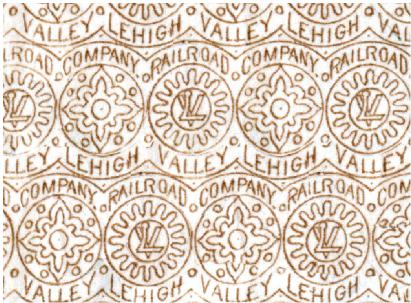
Company initials were often composed into complex and ornate monograms. Their uses as logos became extremely common on checks, stationery, passes, and timetables during the 1880s and 1890s. Monograms even appeared on rolling stock, ironwork, water towers, and buildings. However, this very simple monogram from the Lehigh Valley Railroad Co. is the only one that I remember used as a repetitive underprint on certificates.
I receive many letters from people asking advice about selling collections left by their parents. As I’ve already said, I tell them they have three choices: sell by themselves, sell to dealers, or let auction houses sell for them.
I tell them that selling to dealers is easy and is definitely the best choice for many people. However, conversations suggest that many people are distrustful, especially if they have no one-on-one experience with dealers. Novices seem afraid of being cheated. They seem to strongly prefer auction methods.
When they consider auctions, they really have two approaches: auction houses and eBay.
These days, many sellers naturally think of eBay because of ease of selling. Unfortunately, many sellers expect full retail for their items.
When I suggest auction houses, many collectors argue that auction houses are “too expensive” or “out of my league.”
Regardless of their leanings, I quickly discover that the majority of these desperate correspondents are simply making assumptions without solid information.
Yes, auction houses (most assuredly!) charge to sell collections. And, yes, they often combine ordinary certificates into multi-item lots in order to sell more efficiently. On the other hand, selling items one by one on eBay may not be cost effective either.
If they look at the fully-loaded costs of selling, and leave out their emotional involvement in their collections, I think many sellers will see that their choices are different than they’d first imagined.
Deciding to sell by either auction method is a difficult decision. With one method, sellers must allow others to use skills and judgment concerning their certificates. With the eBay method, sellers must invest large amounts of time doing something they may not be good at.
I don’t know collectors’ skills and I can’t eliminate their emotional involvements, but I can show a better picture of the costs of selling.
The major costs of selling are commissions. According to professionals in the business, major auction houses charge commissions ranging from 15% to 40%, depending on quality of material and sizes of collections.
Commissions are negotiable. Auction houses offer lower commissions when they think they can sell certificates easily. High quality collections receive better commissions than collections loaded with common material.
As best I can tell, all major auctioneers of certificates maintain their own inventories. This practice is reasonable because no house can survive on commissions alone. Still, auction house inventories will inevitably affect commission rates. High in-house inventories will mean high commissions and vice versa.
The more freedom sellers give auction houses to sell their collections, the better their commission rates. For instance, if sellers allow houses to lot and estimate prices as they see fit, they will offer better commissions. If sellers insist on unrealistically high reserve prices or insist items be sold in specific manners, then houses will discourage consignments with high commissions.
I doubt sellers will hear this anywhere else, but I will hint that their reputations will precede them. If sellers are easy to work with, are reasonable, and they try to understand the problems of selling, auction houses will be agreeable and reasonable. It’s just the way the business works.
(The same concepts apply when selling to dealers. I just cannot quantify offers and practices because they are hidden. I have no reliable information, so I cannot possibly estimate how much dealers will offer. I will say that the better the collection the higher dealers’ offers will be as a percentage of “retail.” If sellers have established good relationships with dealers over several years, they will be treated like family. Dealers cannot remain in the business unless they treat buyers and sellers fairly.)
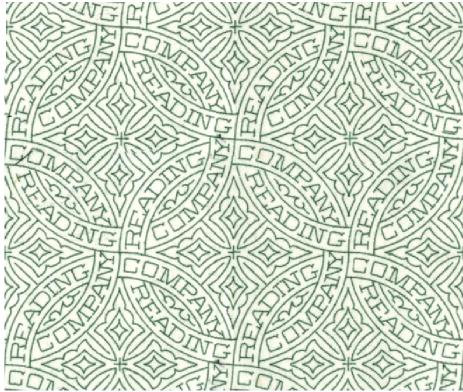
Only a few railroad company names, like this one from the Reading Company, appear as repetitive underprints on certificates. One would think they would have been popular subjects. However, I suspect these designs were harder to create than their simple appearances imply.
Selling through auction houses is painless. There are few, if any, hidden fees. The amounts sellers receive are normally sales prices minus commissions. Simple.
The process of selling on eBay is also simple, but the amount sellers will receive is hard to predict. EBay charges a simple commission, but also adds many special fees. As the previous article shows, it is difficult to achieve good returns across all price ranges. Over the years, eBay’s selling fees have multiplied to accommodate multiple pictures, reserve prices, “buy it now” prices, cross-promotions, bold type, and featured listings. Selling cheap items on eBay is getting expensive. Fortunately, eBay offers special days when sellers can list items at decreased rates.
Selling on eBay requires much work. This is work that would normally be done by dealers and auction houses. Novice sellers don’t seem to value their time. After they sell 40 or 50 items, though, I guarantee they will change their views.
To me, time is a major part of the cost of selling. Therefore I count time and all other fees as part of “effective commission” rates. The more time sellers spend, the higher their effective commission rates. Again, some people think their time is free. I don’t. I’ll politely accept objections, but I will estimate their sellers’ investment at a measly $5 per hour.
Now, let’s estimate “effective commission” rates incurred when selling on eBay.
PLEASE NOTE
The section below estimated fully-loaded costs in November, 2006. Since then, PayPal is no longer involved and eBay has changed several of its other fees. Please consider the issues discussed in 2006, but calculate your actual costs of selling as they exist TODAY.
Commissions are called “final value fees” on eBay. They range from 5.25% for items below $25 to under 3% for expensive items.
Sellers must describe their items. In order to improve sales performances, they must scan or photograph certificates, improve images, and answer questions from potential bidders. My experience suggests sellers will spend an average of 15 minutes per item. If sellers do not already have a good scanner, they should borrow or rent one. Using poor quality pictures from digital cameras is a superb way to decrease sales prices. Novice sellers also prefer to ignore the primary rule of selling: the more you tell, the more you sell.
Fulfillment costs are costs incurred to complete sales. These costs includes gathering shipping supplies, address labels, tape, insurance slips, custom forms, and postage. Ideally, sellers will pass real costs along to buyers in the form of “postage and handling” charges. They must also count the time it takes to complete orders, send email, pack, and ship. I sell newspapers and magazines on eBay and have found that it is almost impossible to spend less than 10 minutes fulfilling an order. If sellers buy postage at post offices, they must count travel times as well as transaction times. They must also add a few cents if they write checks on non-free accounts. (Assuming sellers are super efficient, add 12 minutes per order.)
Collection costs are incurred if buyers do not pay, or do not pay quickly. Fortunately, the eBay failure rate is miniscule, maybe one out of 50. Or less. Assume a minute per order.
Insertion fees are the amounts eBay charges to list items. Fees depend on minimum bid prices (“start prices”) and are grouped by price ranges. Higher start prices mean higher
insertion fees. Starting an auction at $24.99 will cost $0.60, but starting at $25 will cost $1.20.
Reserve fees. Listings can be set up so sellers won’t be required to sell if certificates fail to attract sufficiently high bids. These are called “reserve prices” and eBay charges stiff fees for the luxury. I always avoid reserve fees by starting auctions at my minimum acceptable prices. If sellers tell me they insist on reserve prices, then I suggest they study the charges. Auctions with $49.99 reserves will cost $1, but $50 reserves cost $2. Reserve fees are refundable IF certificates sell.
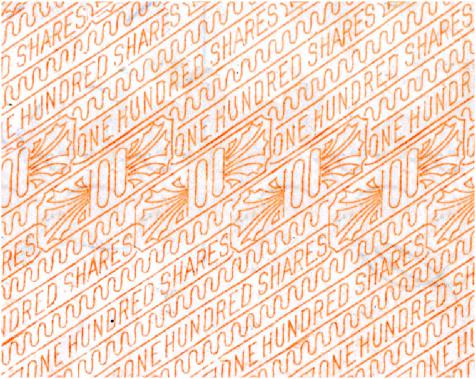 This repetitive design appears in the signature area of Lehigh Valley Railroad certificates used between 1892 and 1901
This repetitive design appears in the signature area of Lehigh Valley Railroad certificates used between 1892 and 1901
Picture fees are the amounts eBay charges for multiple images. The first picture is free. Each additional picture costs $0.15. I suggest that one good quality scan is sufficient for non-autographed certificates. Autographed certificates usually deserve good images of signatures. Novice sellers include too many images.
Gallery fees are extra fees that eBay charges to allow images to appear on search results pages. Gallery images are not necessary, but statistically enhance sales. The charge is $0.35.
PayPal fees. Many sellers require buyers to pay only by check or money order. Unfortunately, the more sellers restrict bidders, the fewer bids they will receive. Statistically, many people buy only from sellers who accept PayPal. In my case, about 92% of buyers pay by PayPal. Payment is immediate, often arriving within minutes of sale closes. PayPal allows buyers to pay by credit card, e-check, and international money transfer. PayPal is not cheap, so sellers can save on fees by establishing business accounts. Fees range from about 2% to about 5%.
The table below compiles all these fees to estimate overall “effective commission” rates on eBay. Using the assumptions listed, the table shows me that effective commissions are high at lower sales prices.
Effective eBay commission
| Sale price |
$25.00 |
$50.00 |
$100.00 |
$200.00 |
$500.00 |
| Start price |
$13.00 |
$25.00 |
$50.00 |
$100.00 |
$250.00 |
| Insertion fee |
$0.60 |
$1.20 |
$2.40 |
$2.40 |
$3.60 |
| Final value fee |
$1.31 |
$2.06 |
$3.56 |
$6.56 |
$15.56 |
| Reserve fee |
$0.00 |
$0.00 |
$0.00 |
$0.00 |
$0.00 |
| Gallery fee |
$0.35 |
$0.35 |
$0.35 |
$0.35 |
$0.35 |
| PayPal fee** |
$1.14 |
$1.75 |
$3.20 |
$6.10 |
$14.80 |
| Description*** |
$1.25 |
$1.25 |
$1.25 |
$1.25 |
$1.25 |
| Fulfillment*** |
$1.00 |
$1.00 |
$1.00 |
$1.00 |
$1.00 |
| Collections *** |
$0.08 |
$0.08 |
$0.08 |
$0.08 |
$0.08 |
|
|
|
|
|
|
| Total costs |
$5.73 |
$7.69 |
$11.84 |
$17.74 |
$36.64 |
| Effective commission |
22.9% |
15.4% |
11.8% |
8.9% |
7.3% |
Sellers can overcome this, to some degree, by lotting multiple items to force sales over $25. They may refuse to have images appear in Gallery. They may refuse PayPal. They may use a third party for image hosting. They cannot avoid the time investment!
I also stress that many fees (insertion, reserve, picture, and gallery), as well as description times, will accumulate regardless of whether certificates sell or not. Non-selling items incur fees. In effect, sellers must count all fees as part of effective commission rates. When sellers count fees from non-selling items, their effective commissions could easily exceed 30% or more across collections of low-value certificates.
When sellers consider both effective commission rates, sales rates (from the previous article), and costs from unsold items, they can see that selling to dealers or selling through auction houses are extremely attractive options.
I use eBay a lot and I think it is a great invention. However, when collectors reach the point of selling their collections, I want them understand ALL their options. And count ALL their costs.
(I apologize to sellers for not compiling this information sooner. I hope you will understand that it has taken years and staggering numbers of hours, to get to this point.)